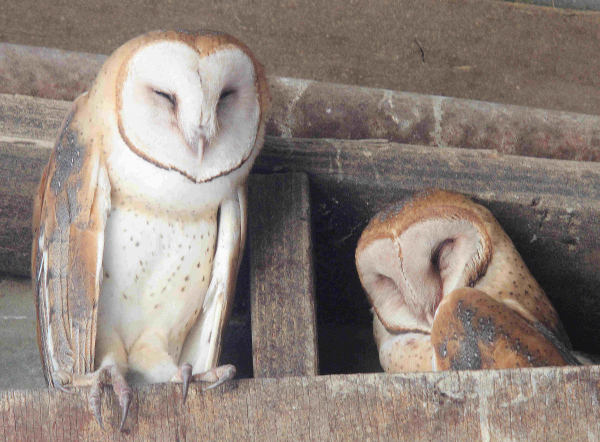
A Barn Owl’s hunting success can be dictated by the color of the owl’s ventral side (photo by Paul Konrad).
|
Barn Owls are efficient rodent hunters, thanks to a combination of excellent low-light vision, silent flight, and otherworldly hearing. But it turns out some Barn Owls have an additional secret weapon in their hunting arsenal – moonlight. Ornithologists have long puzzled over why Barn Owls, which are strictly nocturnal and hunt in the dark, show a spectrum of color variations on their belly and breast feathers: Some individuals are colored white, others are streaked with pale rufous hues, and still others are a rich rufous color on their ventral side.
Geography may play a role in European populations, with rufous owls being more common in the north and whiter owls more common in the south. But variants occur together in all parts of the range, deepening the mystery of why the alternate plumages occur at all.
New research indicates that Barn Owls with white breast and belly plumage have a distinct advantage when hunting, especially on clear nights with a brightly shining, full or nearly full moon. Ornithologists from Finland have been using cameras, GPS tracking units, and direct observations to study a population of Barn Owls in western Switzerland for more than two decades, acquiring a wealth of information about nesting and feeding behavior in the process.
“We thought they would have a harder time hunting . . . on moonlit nights,” wrote Almut Kelber, professor of biology at Lund University in Sweden and an author of the research publication. “In the bright moonlight, owls should be more easily spotted by prey such as mice. If this was true, hunting on moonlit nights would be even trickier for white owls than for rufous owls, simply because white is more reflective and therefore more visible in the moonlight than rufous plumage. As it turns out, we couldn’t have been more wrong.”
Their research and analysis showed that Barn Owls were less successful hunters on moonlit nights, but when they looked at the relative success of rufous vs. white Barn Owls, the story proved to be more complex. Rufous-colored owls consistently brought less food to their nests on moonlit nights. White-colored owls, on the other hand, seemed to have equal or greater success in food-provisioning on nights when the moon shined brightly.
To further investigate, the researchers directly measured the reactions of individual voles to rufous and white Barn Owls by using specimens mounted by taxidermists in a spread-wing position. Under two levels of simulated moonlight – a new moon and a full moon – the mounted owls were positioned five to six feet above the voles, although they were hidden behind a dark curtain before being revealed to the rodents.
As expected, voles were better at detecting and reacting to owls under the full-moon conditions, and the most common reaction by far was to stop moving and “freeze” in position. How long they stayed motionless depended significantly on what color the owl was.
Across all trials, the average amount of time a vole stayed motionless was about nine seconds. Under full-moon conditions, voles remained motionless 9 seconds longer when facing a white owl than they did under the relative darkness of a new moon. Also under full moon, voles remained motionless about 5 seconds longer when they encountered a white-colored owl as compared with a rufous-colored owl. In the darkness of a new moon, voles showed no difference in their response to the two different-colored owls.
“We think voles behave that way when encountering a white owl because they’re scared by the bright light reflected from the white plumage,” said Kelber.
It’s almost as if they were ‘a deer in the headlights.’ Although stopping motion can be a helpful prey response to avoid predators in some situations, researchers think in this case the reaction gives a Barn Owl the advantage because they are already zeroed in on their target and white-colored Barn Owls get a few more seconds to pounce on their prey.
Given this advantage, we might expect natural selection to favor the white owls, and for the rufous owls to eventually disappear. But the study authors believe there may be other factors at play. For example, darker feathers tend to be stronger and resist wear better than whiter feathers. The rufous owls might also be better camouflaged when roosting or stalking prey.
The newly published article referenced in this article is cited as: San-Jose, L.M., et al. 2019. Differential fitness effects of moonlight on plumage color morphs in Barn Owls. Nature Ecology & Evolution 3: 1331–1340.
To reference the original article, go to https://www.allaboutbirds.org/under-a-full-moon-barn-owls-with-pale-plumage-can-freeze-voles-in-their-tracks/